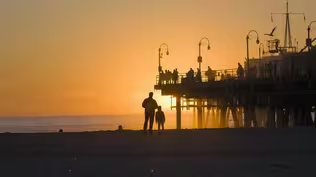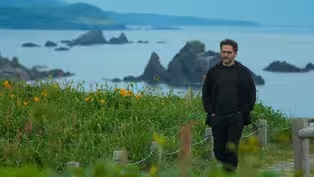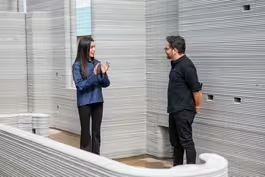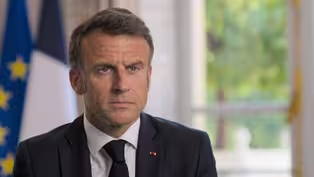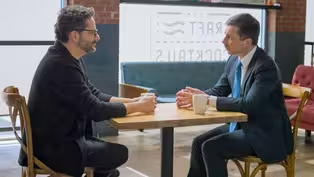
The Future of Sustainable Housing
Clip: Episode 5 | 9m 35sVideo has Closed Captions
Ari explores better, more sustainable ways of living together going forward.
Ari travels to Amsterdam to experience a floating village that showcases an innovative approach to sustainable living and community building. The community's commitment to sustainability, shared resources, and social interaction serves as a model for fostering human connection and environmental responsibility.
Problems playing video? | Closed Captioning Feedback
Problems playing video? | Closed Captioning Feedback
Supported by the Hoveida Family Foundation and The Rosalind P. Walter Foundation.

The Future of Sustainable Housing
Clip: Episode 5 | 9m 35sVideo has Closed Captions
Ari travels to Amsterdam to experience a floating village that showcases an innovative approach to sustainable living and community building. The community's commitment to sustainability, shared resources, and social interaction serves as a model for fostering human connection and environmental responsibility.
Problems playing video? | Closed Captioning Feedback
How to Watch A Brief History of the Future
A Brief History of the Future is available to stream on pbs.org and the free PBS App, available on iPhone, Apple TV, Android TV, Android smartphones, Amazon Fire TV, Amazon Fire Tablet, Roku, Samsung Smart TV, and Vizio.
Buy Now
Providing Support for PBS.org
Learn Moreabout PBS online sponsorship[upbeat music] ♪ ♪ - We spend a lot of time these days separating ourselves into groups based on ideas and identity.
But I wanted to see what's possible when a local community decides to build together around a shared sense of belief and belonging.
In Amsterdam, Marjan de Blok decided to do just that, when she helped create a floating village right here in the heart of the city.
Usually when I show up to a village, I just take, like, a path, and I just, you know, start walking among the homes.
- Mm-hmm.
- But here I immediately walked on to a dock on the water.
So tell me where we are.
- You ae in the north of Amsterdam in Johan van Hasseltkanaal.
And I'm the founder of this village that you are in right now.
One school is-- one school is here, very near.
So we have a big jetty connecting all the houses.
There are actually 46 households living here.
We are a community, so we share a lot together.
And we try to live as sustainable as possible.
All our houses have solar panels.
All our houses have a heat pump.
We have a green roof, and all the houses are built with sustainable materials.
All houses are really well insulated.
And we have a smart grid, which is quite special.
By the smart grid, we are all connected, so we can exchange the surpluses of the energy we generated.
And all the houses have a battery.
And in this battery, we can also save energy that we don't need at that moment.
- If one house generates more electricity and another house needs more electricity, you can share electricity among the homes?
- Yeah.
That's how it goes.
- So what was the motivation for starting a community like this?
- Well, it actually started 15 years ago.
At that time, I was living in a small house in Amsterdam.
I hardly knew my neighbors, and it was all really kind of lonely and individualistic.
And I just completely fell in love with the concept of living sustainable on the water, but also to live a more social life, because that was something that I was really missing at that time.
I had this idea of starting a group.
Build a couple of houseboats together, make them sustainable.
And living on the water makes you feel closer to nature.
And the fact that you would generate your own electricity gave me this really great sense of freedom, a feeling that I would never have in the house that I was living in.
[indistinct chatter] [light music] ♪ ♪ Whoo.
- So tell me more about what it's like living in community.
- Yeah.
It's "uncomparable."
It's "uncomparable."
It's a feeling... You are never alone.
You have like-minded people around you.
If you have to do everything by yourself, it's not fun.
And so then the community makes it nice to try all these new sustainable technologies.
So I really think that the community is needed for a transition to a more sustainable society.
Hi.
- Hello.
- Ooh.
When I started this or when I had this initial idea, I had no idea how important it was, what we were doing.
[indistinct chatter] And that it's also about, what can you do, instead of what you can't do or what is-- you can't eat meat.
You can't drive a car.
You can't fly.
It's all, like, negative.
And, of course, those things are important to keep in mind and to adjust your behavior, but there's also another side to it.
And I think that's the side that we touched and realized here with this community, because it's all positive.
It's all about connection-- connection to your neighbors but also connection to your environment.
If you are connected to your environment, you will think twice before polluting it.
There's a lot of respect for one another, and I think everybody realizes that it's not just a jetty with some houses.
I feel that it's an organism that is still growing, and it's almost an organism in itself, like, a live thing.
It's not just a project.
And I think people realize that.
So they know it's special, what we have.
And that's a really nice feeling if you have that in your daily life.
[both speaking Dutch] - It's so exciting to think about the futures we can create when we design with human connectedness in mind.
Collaboration and cooperation is how we got to this point, and it's our only path forward.
And yet, in so many ways right now, it feels like we're moving further away from these primary human traits.
- What makes us special?
Why have we, humans, conquered the globe?
Why not the Neanderthals, you know?
The Neanderthals were pretty smart as well.
Actually, they had bigger brains than us.
Why not the bonobos?
Why not the chimpanzees?
What distinguishes us as a species?
- All of us are individuals.
And we have individual needs, wishes, wants, desires, and so on.
But we also are part of social groups that can mean a lot to us.
- Being human is this team sport, is this collective, collaborative endeavor that we actually have to bring ourselves to.
This whole story of evolution, that may the best man win-- that's not what Darwin was saying at all.
Page after page, what he's actually doing is marveling at the way different species communicate and collaborate for mutual survival.
- There's a really old idea that's deeply embedded in our culture and in our history, which says that human beings are fundamentally selfish.
So what scientists now believe is that the secret of our success is not our intelligence.
It's not our strength.
No, it's our ability to work together.
It's our friendliness.
So this is what they call survival of the friendliest, and it's basically the secret of our whole story.
[upbeat music] - These ideas matter more than ever because we have important, unfinished things to do right now that we can only do together.
One of these things is creating enough housing for everyone who needs it.
In Austin, Melodie Yashar and her team at ICON are working on ways to meet this challenge by building 3D-printed homes that can be printed in a matter of weeks.
Okay, so tell me, where are we right now?
- We are in House Zero.
House Zero is a project that we both designed and built in collaboration with the architect Lake Flato.
And it is intended to showcase what is possible using 3D printing.
It is a project that we took on as a research-and-development effort to show what's possible and to introduce to the general public what it's like to live on the inside and be on the inside of a 3D-printed home.
- Give me a sense of the problem.
Like, how many people are we talking are unhoused in the U.S. and globally?
- It's close to a billion people, a billion homes that we need to deliver to address the global housing crisis.
The way that we've been building, using sticks and bricks of the past and steel, is just not getting us there fast enough.
And so, to really address and make a true impact in this problem, automated technologies can get us there.
And 3D printing, of course, is one of them.
- Take me through what actually happened here and in general, right?
We'll start off with a concrete slab.
So you have level ground.
Now what happens?
- Once a slab is poured, we deploy our 3D printer, which is a 9,600-pound Gantry-based robot.
We deploy it on rails adjacent to that slab.
So the Y rails run back and forth and parallel to the slab.
And then we have two towers, as well as an X beam, that goes across those towers, which essentially comprise the overall Gantry system.
We have a material-handling system that travels through a very long hose and gets deposited at the nozzle of the printer.
And layer by layer, the structure is fabricated.
[gentle music] We are at the Wolf Ranch development.
This is a 100-home community.
This represents the largest 3D-printed community that we're aware of in the world.
And as you can see, it's well underway.
We have multiple printers printing simultaneously, adjacent to slabs that have been poured by Lennar.
And we're delivering the vertical-wall system, which is the 3D-printed walls of these houses.
- And how long does it usually take for one of these homes to go up?
- Roughly two weeks on average, assuming that we have continuous 24-hour-a-day printing.
But that's essentially the idea, is that we deploy the printer within a day.
The printer prints the home, and the home is finished traditionally.
You put on a traditional roof.
Your plumbing and all of that, electrical, happens still traditionally.
Video has Closed Captions
Preview: Ep5 | 30s | How can we create futures that serve the needs of all people? (30s)
Video has Closed Captions
Clip: Ep5 | 1m 26s | 3D printed homes pose a potential solution to addressing the growing housing crisis. (1m 26s)
The Power of Deliberative Democracy
Video has Closed Captions
Clip: Ep5 | 8m 52s | Ari explores forms of deliberative democracy around the world that empower citizens. (8m 52s)
The Vital Importance of Better Infrastructure
Video has Closed Captions
Clip: Ep5 | 3m 4s | Building better cities and transportation can influence human connection and cooperation. (3m 4s)
Providing Support for PBS.org
Learn Moreabout PBS online sponsorshipSupport for PBS provided by:
Supported by the Hoveida Family Foundation and The Rosalind P. Walter Foundation.
